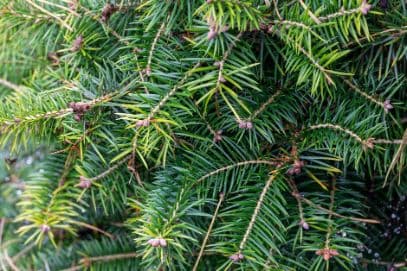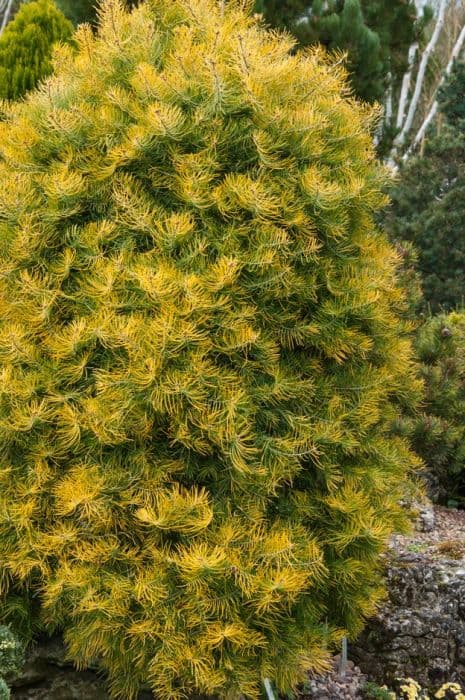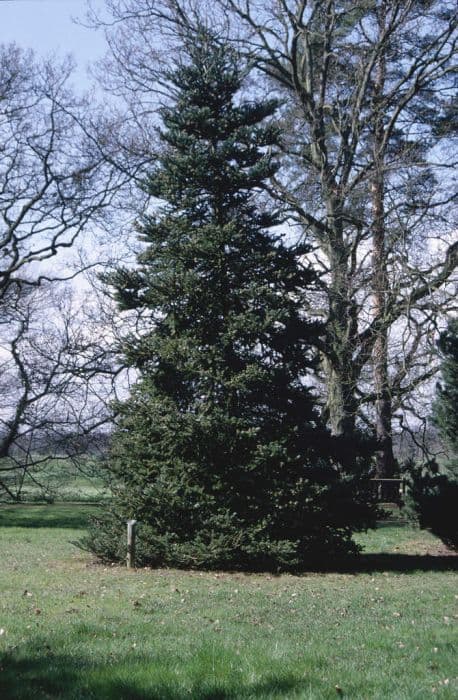Scots Pine Pinus sylvestris 'Beuvronensis'

ABOUT
The plant in question, commonly known as Scots Pine 'Beuvronensis', embodies the distinctive appearance representative of its species, yet with its own unique traits. This cultivar typically showcases a compact and rounded form with dense foliage, providing a robust and bushy appearance that is quite striking in landscape settings. The needles of Scots Pine 'Beuvronensis' are a notable feature, possessing a rich, deep green color that can bring a touch of evergreen vibrancy to its surroundings throughout the year. These needles, arranged in pairs, are relatively stiff and short, creating a somewhat bristly texture when touched or seen from a distance. This particular pine is also recognized for its bark, which may display a pleasing contrast in color and texture against the foliage. The bark may vary in shades and typically exhibits a rugged character that is typical of pine species. As a cultivar of Scots Pine, the 'Beuvronensis' variant does not significantly deviate from the visual qualities of its parentage in terms of needle, bark, and general silhouette; however, it does possess nuances that make it distinctive. It shares the coniferous nature of other pines, bearing cones that contribute further to its overall aesthetic appeal. The 'Beuvronensis' selection maintains the conifer's traditional resilience, with the capability to endure in a variety of settings. It flourishes best in well-drained soils, and once established, it becomes a steadfastly present element in the landscape. It is often chosen for its ornamental qualities and ability to provide year-round interest and texture in gardens and parks.
About this plant
 Names
NamesFamily
Pinaceae
Synonyms
Beuvronensis Scots Pine, Beuvronensis Scotch Pine
Common names
Pinus sylvestris 'Beuvronensis'
 Toxicity
ToxicityTo humans
The plant in question is commonly known as Scotch pine. Scotch pine is generally not toxic to humans; however, ingestion of needles or sap in large quantities could potentially cause gastrointestinal irritation or discomfort. Pine needles can be sharp and may cause physical injury to the mouth, throat, or digestive tract if swallowed. It is not common for humans to eat parts of pine trees, and they are not typically considered poisonous. If large amounts of pine plant material are ingested and symptoms such as nausea, vomiting, or diarrhea occur, it is important to consult with a medical professional.
To pets
The Scotch pine, while not highly toxic, can be mildly harmful to pets if ingested in large quantities. The needles can cause gastrointestinal irritation, vomiting, or diarrhea. The sharp needles can also cause physical injury to pets' digestive tracts. Additionally, the oils found in pine needles may irritate the mouth or stomach. If a pet consumes a large amount of pine needles or shows signs of distress after ingesting parts of the plant, it is advisable to consult a veterinarian.
 Characteristics
CharacteristicsLife cycle
Perennials
Foliage type
Evergreen
Color of leaves
Green
Height
4-6 feet (1.2-1.8 meters)
Spread
2-4 feet (0.6-1.2 meters)
Plant type
Tree
Hardiness zones
3
Native area
Europe
Benefits
 General Benefits
General Benefits- Low Maintenance: Pinus sylvestris 'Beuvronensis' is a low-maintenance tree that does not require frequent watering or pruning.
- Drought Tolerance: Once established, it has a high tolerance to drought, making it suitable for xeriscaping.
- Soil Adaptability: It can adapt to a range of soil types, from sandy to clay, as long as they are well-drained.
- Cold Resistant: This plant can withstand cold temperatures, making it a good choice for cooler climates.
- Windbreak: Its dense growth habit makes it effective as a windbreak, providing shelter from strong winds.
- Erosion Control: The root system helps to stabilize soil and prevent erosion, especially on slopes.
- Habitat Support: Provides shelter and cones as a food source for wildlife such as birds and small mammals.
- Ornamental Value: The distinctive twist of the needles and the overall form of the tree make it an attractive landscape specimen.
- Longevity: It is a long-lived species, providing benefits to the landscape for many years.
- Seasonal Interest: Offers year-round greenery and color accent in the landscape.
 Medical Properties
Medical PropertiesThis plant is not used for medical purposes.
 Air-purifying Qualities
Air-purifying QualitiesThis plant is not specifically known for air purifying qualities.
 Other Uses
Other Uses- The Scotch pine's resin can be used in the production of turpentine, which is an important solvent for varnishes and paints.
- Wood from Scotch pine is often used in the construction of pallets, crates, and other packing materials due to its strength and availability.
- The tree can be cultivated for Christmas tree production, as it holds its needles well and has a pleasant pine scent.
- Scotch pine's wood is suitable for making pulp, which can be used in the paper manufacturing industry.
- The needles of Scotch pine can be used as a natural mulch in gardens, providing protection to soil and plants during colder months.
- When dried, the pine needles can be used to stuff traditional Alpine pillows, believed to encourage restful sleep.
- Scotch pine cones can be used in crafts and as a natural decoration, especially during the festive season.
- The tree is sometimes planted as a windbreak in agricultural settings, due to its tolerance to wind and fast growth.
- Scotch pine wood can be used in the creation of rustic furniture, which is valued for its knotty and rugged appearance.
- Essential oils derived from Scotch pine needles can be used in aromatherapy for their refreshing and invigorating scent.
Interesting Facts
 Feng Shui
Feng ShuiThe Scots Pine is not used in Feng Shui practice.
 Zodiac Sign Compitability
Zodiac Sign CompitabilityThe Scots Pine is not used in astrology practice.
 Plant Symbolism
Plant Symbolism- Resilience: Pinus sylvestris, commonly known as Scots Pine, is known for its hardy nature and ability to thrive in challenging environments, which symbolizes endurance and the capacity to withstand hardships.
- Longevity: Scots Pine trees can live for hundreds of years, representing longevity and continuity.
- Wisdom: With age, these trees accumulate knowledge of the seasons and the land, embodying wisdom and insight gained over time.
- Purity: The evergreen leaves of the Scots Pine symbolize purity and eternal life, as they remain green throughout the year, even in harsh winters.
- Peace: The presence of pine trees in many cultures signifies peace and tranquility, offering a space for reflection and meditation.
- Fertility: The prolific seed production and widespread growth of Scots Pine stand for fertility and the ability to prosper.
 Water
WaterThe Scots Pine 'Beuvronensis' variety should be watered deeply whenever the top 2 to 3 inches of soil feel dry to the touch. It's essential not to water it too frequently to prevent waterlogged soil, which can lead to root rot. During the growing season, this may mean watering every week, especially in dry conditions, with an approximate amount of 1 to 2 gallons for younger trees and significantly more for established ones, depending on their size and the weather. During the dormant season, reduce watering to when it appears necessary, likely once or twice a month. Always ensure adequate drainage to avoid standing water around the base of the tree.
 Light
LightScots Pine 'Beuvronensis' thrives best in full sun conditions, preferring at least six hours of direct, unfiltered sunlight per day. The ideal spot for this plant would be in an open space away from taller structures or trees that could cast shade on it. They are adaptable and can tolerate partial shade but grow most vigorously with abundant light.
 Temperature
TemperatureScots Pine 'Beuvronensis' can withstand a wide range of temperatures, from well below freezing to hot summer temperatures. It is hardy and can survive in temperatures as low as -30 degrees Fahrenheit. The ideal temperature range for growing this pine variant is between 60 and 70 degrees Fahrenheit during its active growth periods. Extreme heat above 90 degrees Fahrenheit may not be ideal, but the plant is generally quite tolerant.
 Pruning
PruningScots Pine 'Beuvronensis' can be pruned to maintain health and remove any dead or damaged branches, typically in late winter when the tree is dormant. Pruning is also beneficial for shaping the tree or controlling its size; however, this should be done sparingly as pines do not require extensive pruning. The best time for any structural pruning is in the late winter or early spring before new growth begins. Pruning should not be done in late summer or fall, as it can stimulate new growth that might not harden off before winter.
 Cleaning
CleaningAs needed
 Soil
SoilScots Pine 'Beuvronensis' thrives in well-draining, acidic to neutral soil with a pH range of 5.5 to 7. A mix of loam, peat, and coarse sand can ensure proper drainage and root aeration. Regular garden soil can be amended with organic matter to improve structure.
 Repotting
RepottingScots Pine 'Beuvronensis' is a slow-growing plant and typically needs to be repotted every 2 to 4 years. It's best to repot during spring before new growth begins, using a slightly larger pot to accommodate root growth.
 Humidity & Misting
Humidity & MistingScots Pine 'Beuvronensis' is tolerant of a wide range of humidity levels and is well-suited to outdoor conditions. Optimal results are achieved in moderate to high humidity environments that mimic its natural setting.
 Suitable locations
Suitable locationsIndoor
Provide bright light, cool temps, avoid overwatering.
Outdoor
Full sun, well-draining soil, and winter frost protection.
Hardiness zone
3-7 USDA
 Life cycle
Life cycleThe life of a Scots Pine, specifically the cultivar Pinus sylvestris 'Beuvronensis', begins as a seed, which under suitable conditions germinates and sends out a small root and shoot. The seedling stage follows, where the plant focuses on root development and puts out its first needles. As it grows into a sapling, the Scots Pine develops a sturdy trunk and starts establishing its characteristic conical crown. During the mature stage, the tree reaches its full height and size, producing cones annually that contain seeds for reproduction. Throughout its life, which can span several centuries, the Scots Pine undergoes cycles of needle growth and shedding, maintaining its health and vigor. In its final stage, the tree may become senescent, slowing in growth and producing fewer cones until it eventually dies.
 Propogation
PropogationPropogation time
Spring to early summer
The most popular method of propagation for Pinus sylvestris 'Beuvronensis', commonly known as Scots Pine, is through seed collection and sowing. Cones from the parent plant should be collected in late fall, and they will require a period of cold stratification to break dormancy, usually lasting about 60 days at around 34-40 degrees Fahrenheit (1-4 degrees Celsius). After stratification, the seeds are sown in well-draining soil under bright, indirect light. Germination can be slow and irregular, but once seedlings emerge, they should be gradually acclimatized to outdoor conditions before transplanting them to their permanent location. This process emphasizes the importance of patience and careful attention to temperature and moisture to ensure successful germination and growth of the Scots Pine.









